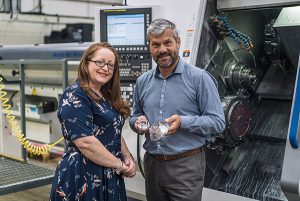Cannock-based Kenson Industrial Plastics has invested in a Tornos DT26 turning centre to help it machine spacers, rollers, washers, threaded gears, insulating pads and machine guarding from materials such as nylon, polyethylene, PVC, PTFE, PEEK and other plastics.

The four-employee company won a contract to manufacture gear motor components in batches of 10,000 per month, and this instigated the search for a new turning centre.
Managing director Kevin Hutcheson says: “The parts being machined are only 12 mm diameter. We looked at all the sliding-head suppliers, as well as a few other options, but the Tornos DT26 fitted our business perfectly. Other vendors recommended running neat oil, which is standard for sliding-head machines. However, Tornos said we could run the DT26 with either soluble or neat oil. As we machine plastic parts, we want to avoid staining from oil, or cleaning oil from plastic parts. Tornos had instantly tipped the scales in their favour.”
The machine instantly reduced the cycle time of the gear components (which are made of Ertalyte TX) from 50 to 25 seconds per part, taking more than seven days off the previous monthly production schedule. Additionally, the facility to work with and without the guide bush has reduced material consumption.
Historically, Kenson has only operated on a single eight-hour shift basis. However, the Tornos DT26 has been supplied with a
3 m barfeed and the Tornos Active Chip Breaker (ACB) system for lights-out machining. Referring to this, Hutcheson says: “We’ve only ever run day-shift machining, but now we have the Tornos and its ACB system, we can look at unmanned running.”
For further information www.tornos.com























